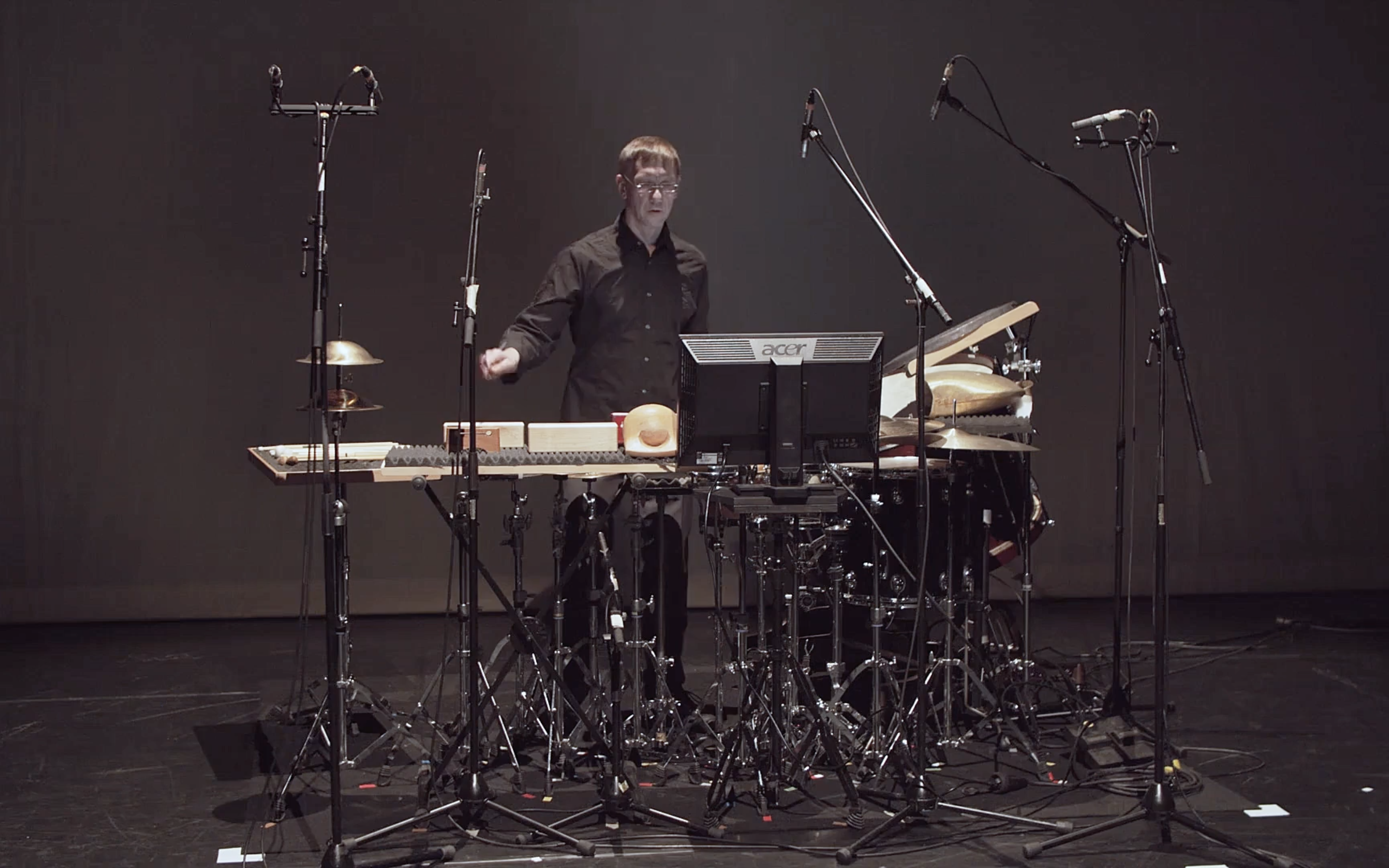On January 10th 2022 Michael Pattmann premiered ma bell, a reworking of ma bel. For one beautiful bell and four percussion groups consisting of six objects each of wood, metal, drum, and plate plus computer (the latter producing 3rd-order ambisonics surround sound) this is essentially a piece for percussion and sampler, in the form of custom MaxMSP software.
programme note
ma bell was written for Michael Pattmann. It is a re-working of ma bel which in turn was written for Jean-Francois Laporte and his composite compressed-air instrument, the Babel Table. The titles’ connections to the Old Testament myth explaining the origin of the world’s different tongues is intentional.
The title ma bel transposes merely one character of ba-bel. ma bell goes one step further in merely repeating a character but in doing so connects to a key percussion instrument. These simple elaborations offer several meanings to speakers of different languages: as a homonym in French (ma belle) it could refer to my beautiful (wife, daughter, belle-sœur, etc.) or imply the more complete ma belle vie; in English it could be misheard as marble (the stone but also the child’s toy) or refer to Mabel, the woman’s name; but in Arabic ma bel means what but, after which I particularly enjoy question marks and perhaps even a why?—good things to ask about a piece of music such as this.
So then: just a few symbols, and even fewer syllables, but so much meaning and context. Babel connects back beautifully to this in that, obscured from its mythological-biblical context, it refers more generally to a confusing mélange (as in mixture, not the Viennese coffee :): a mêlée, in the non-violent sense, of sounds and voices or a noisy, confused scene in general. Such is ma bell: a plethora of unrelated samples mixed with the potent sounds of varied percussion, all driven by a score which is digital yet conventionally notated.
What you see or read, however, is by no means what you get (I’m referring now particularly to the score). The symbols need even more translation, interpretation, and making sense of than usual. And that’s not just the musician’s job but the audiences’ too (as always), given the sound structures on offer.
And further: ma bell integrates strongly emotive vocal utterances from a certain Austrian female; samples that are prelingual but often guttural (synonyms perhaps here: before the tongue, as in before language as well as the muscle)—even guttural in both senses: articulated in the throat and perhaps unpleasant or strange—and most definitely communicative, in a nonsensical way, bien sûr.
This is what music is: by no means a language but nevertheless able communicate or rather provoke a wide variety of experiences, and transporting meaning (or not) to individuals formed both collectively and uniquely. (Ahh… ma bel(l)(e) musique)!)
Ambeo Recording
This performance was also the first time Folkwang recording engineer Arthur Jogerst tried our new Sennheiser Ambeo microphone for surround recording. One of the issues with recording such a piece—which in this performance was presented on only four speakers surrounding the audience in a fairly traditional (though very wide) quadrophonic setup—is how to capture the rear speakers. As usual, Arthur did a lovely job of capturing the performance with several pairs of stereo microphones facing forwards. The Ambeo mic was of course better able to capture the sound emanating from the rear speakers. Here is Arthur’s stereo mix without the Ambeo:
And here’s an unadorned stereo binaural render of the Ambeo surround recording created with the dearVR Ambi Micro plugin:
(Both files are uncompressed waves, so they might take a while to download, but at least no compression artefacts will disturb comparison of the two.)
The increased sense of space is very apparent in the Ambeo render. In particular it does a great job of capturing the colours and spatial presence of the computer part. The live percussion sounds a little more diffuse, perhaps too diffuse even (the percussion was amplified through the front, very wide stereo speakers), whereas Arthur’s stereo mics on the percussion make for a more focused and more lively percussion image. Nevertheless, considering that the single Ambeo mic was placed in the middle of the audience, I was pleasantly surprised at the overall balance and sense of ambience. Given the name and nature of the microphone though, perhaps the latter should not be too surprising.
In the video below I mixed the Ambeo and Arthur’s stereo recording and adjusted the stereo image (in particular to bring the live percussion more into focus on the Ambeo tracks), adding EQ and dynamics processing for a ‘hotter’ master more suitable to net presentation on YouTube etc. I also re-recorded the ‘dry’ MaxMSP patch in post-production and mixed this in.
From the same ‘pepped-up’ mix I also created a 5.0 surround render which can be downloaded.
Thanks to Michael Pattmann for a great performance, as well as attention to detail in the video image processing, and to Arthur Jogerst for the recording.


Leave a Reply